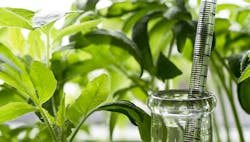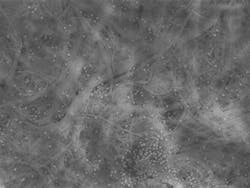Sustainability: Tree Research Branches Out
Trees are big business in Finland. According to the Finnish Forestry Industries Federation, Helsinki, the country manufactured 9.5 million metric tons of paper and paper board in 2019 — however, this is down 10% compared to the previous year.
In recent years, Finland has been looking beyond the paper industry and investigating how to use natural fibers, such as the cellulose from trees, in applications that currently rely on fossil-fuel-based plastics. These include packaging, hygiene products, building materials, textiles, filters and more.
Figure 1. A scanning electron microscope shows how the microplastic particles are attached to the nanocellulose structure. The diameter of the plastic particles is 100 nm. Source: VTT
In April this year, Finland’s research, development and innovation organization, VTT, Espoo, launched two initiatives to investigate possible alternative uses.
The first project, “Piloting Alternatives for Plastics,” will run for three years. The European Regional Development Fund (ERDF), VTT, and 52 companies from across Europe coordinated by the Regional Council of Central Finland, are funding the €6.7-million ($7.3-million) effort.
Together, VTT and the companies are undertaking several pilot projects to investigate the challenges involved with scaling up manufacture of new-generation fiber products. The collaboration draws on a range of engineering expertise including polymer dispersion specialists, pulp and paper manufacturers, engineering consultants, water treatment companies, and pumping specialists.
Based at VTT’s technical research center in Jyväskylä, the pilots will have access to novel technologies, including what the organization says is the first research environment in the world to utilize a foam-forming process.
Some of the same companies were involved in an earlier €3.6-million ($3.9-million) project to investigate the possibility of using foam-forming technology. The process uses tiny bubbles of air mixed to a water/fiber suspension to expand the use of natural fibers in the production of recyclable and lightweight products.
According to VTT, this work overcame the problems that foam causes in paper mills, allowing them to improve resource efficiency. However, it also showed that foam-assisted forming technology introduced opportunities to develop new types of sustainable wood fiber products.
“In this [new] project, we are creating a new understanding of bio-based fiber networks and how, by tailoring them, we can produce new types of recyclable materials that do not burden the environment,” says VTT vice president Jani Lehto.
The challenge now, he adds, is to select the most interesting from a range of raw material and manufacturing options, and to reduce the time it takes to scale the laboratory results to commercial production levels.
The companies involved can then use this information to develop and tailor their own specific processes.
VTT’s second initiative involves using nanocellulose-based films and hydrogels to support the capture and identification of very small microplastic particles before they enter waterways.
“Nanocellulose has a mesh-like, porous structure and a large surface area. In the water, powerful capillary forces are generated in this structure, allowing particles to be transported inside the mesh and bound there,” says VTT research professor Tekla Tammelin, pointing out that 1,000 L of seawater can contain up to 8.3 million microplastic particles.
The method provides a way to catch microplastic particles of a size the human eye can’t detect — those with a diameter of only 100 nm.
“Nanocellulose structures can be used to identify and analyze these particles and to obtain information about their behavior at an earlier stage. We can determine the concentration of particles in water and analyze, for example, whether particles are released into drinking water from plastic bottles,” she notes.
VTT pioneered the identification of microplastic particles using nanocellulose structures as a part of the FinnCERES flagship project, which is exploring new bio-based material solutions. Based at Aalto University, Aalto, FinnCERES is the joint competence center for the materials bioeconomy between the two organizations. It aims to create new businesses based on novel value-added products manufactured from wood constituents that contribute to the renewal of the Finnish forestry industry.
The next step could be to develop new and inexpensive filtration solutions employing the method.
“New filtration solutions would allow particles to be captured where they are generated. The solutions could be utilized, for example, in laundry, where microplastic particles are released from fleece clothing and other synthetic fibers. Similarly, we could develop filtration methods for any industry where there is a risk of microplastics being generated and released into waterways,” concludes Tammelin.
Seán Ottewell is Chemical Processing's editor at large. You can email him at [email protected].


